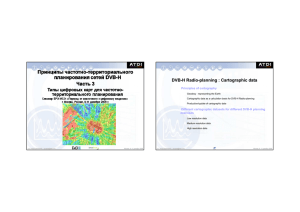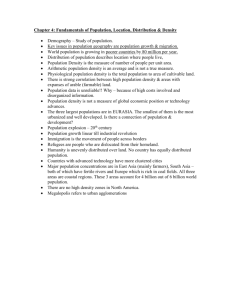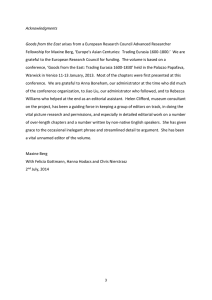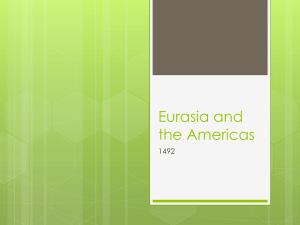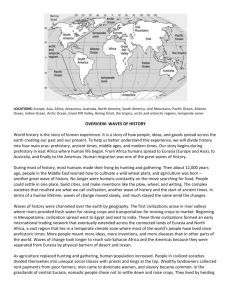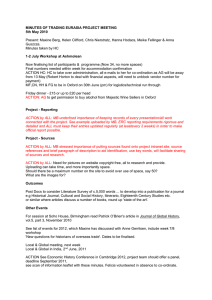The DVB - H transmitter The main technical parameters
advertisement
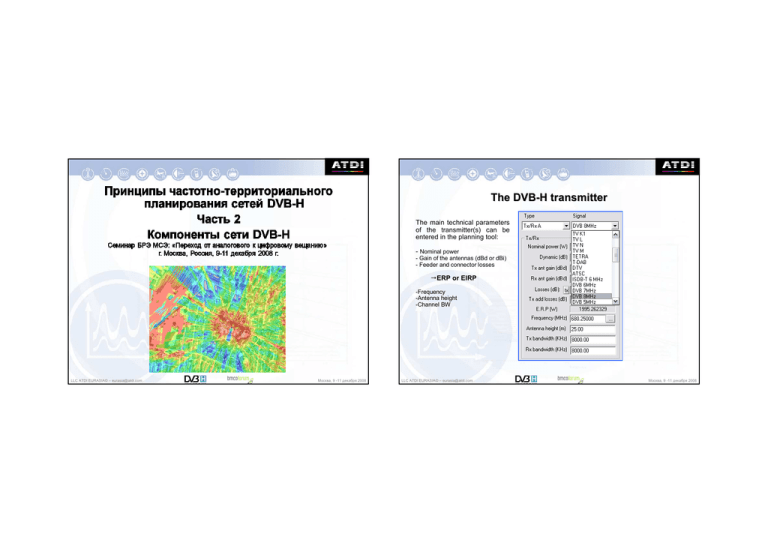
The DVBDVB-H transmitter The main technical parameters of the transmitter(s) can be entered in the planning tool: - Nominal power - Gain of the antennas (dBd or dBi) - Feeder and connector losses ERP or EIRP -Frequency -Antenna height -Channel BW LLC ATDI EURASIA© – eurasia@atdi.com Москва, 9 -11 декабря 2008 LLC ATDI EURASIA© – eurasia@atdi.com Москва, 9 -11 декабря 2008 The DVBDVB-H transmitter The DVBDVB-H reciever: reception criteria DVB vs analogue The radiation pattern of the transmitter can be defined. Antennas systems from panels can be modelled. The required parameters are: digital - The HRP - The azimut - The VRP - The tilt - The polarization (H, V, M, C) Excellent analogue midopinion Unusable E (dB) threshold LLC ATDI EURASIA© – eurasia@atdi.com Москва, 9 -11 декабря 2008 LLC ATDI EURASIA© – eurasia@atdi.com Москва, 9 -11 декабря 2008 The DVBDVB-H reciever The DVBDVB-H reciever: reception criteria The ETSI specifies different classes of reception: Situation Characteristics 1.5m above ground level up to 130 km/h 1.5m above ground level 3 km/h 1.5m above ground level up to 130 km/h Mobile Outdoor (or roof-top) Class A Portable outdoor pedestrian Classe D Mobile in-car Class B B1 Portable light indoor B2 Portable deep indoor 1.5m above ground level 3 km/h lightly shielded building 1.5m above ground level 3 km/h highly shielded building The BMCO specifies different usage scenarios: Field strength Class of reception Class C The reception of a DVB-H handset can be modelled using two kinds of thresholds: - A field strength threshold C: depends on the propagation environment - A C/N threshold: depends on the modulation used, if MPE-FEC is used... 64QAM 7/8 C/N 16QAM 3/4 QPSK 1/2 Quality of coverage Usage scenario Acceptable Good Class C Mobile Roof-top BMCO 1 BMCO 2 Class A Portable Outdoor pedestrian BMCO 1 BMCO 2 Class D Mobile In-car BMCO 3 BMCO 4 Class B1 Portable light indoor BMCO 3 BMCO 4 Class B2 Portable deep indoor BMCO 4 BMCO 5 C/N C/N Noise Floor Distance LLC ATDI EURASIA© – eurasia@atdi.com Москва, 9 -11 декабря 2008 LLC ATDI EURASIA© – eurasia@atdi.com Москва, 9 -11 декабря 2008 The link between the transmitter and the reciever The link between the transmitter and the reciever The computation of the coverage threshold Emed can be obtained by the following equation: The computation of the coverage threshold Emed can be obtained by the following equation: Emed = F + 10 log10 (k T0 B) + C/N – G + 107.2 + 20 log10 (f) + Lo + Lp + QC Emed = F + 10 log10 (k T0 B) + C/N – G + 107.2 + 20 log10 (f) + Lo + Lp + QC F: receiver noise figure. It assumed to be 6dB in DVB-H UHF k: Boltzann’s constant (1.38 10-23 Ws/K) T0: Absolute temperature (290 K) Channel (MHz) 5 6 7 Receiver bandwidth (Mhz) 4.75 5.71 6.66 B: Receiver noise bandwidth in Hz C/N: Carrier to Noise ratio required b the system at the receiver input. Examples are provided here-below (source: BMCO, 8 MHz BW in UHF, MPE FER 5%, max 120 Hz Doppler shift (186 km/h)) G:antenna gain related to isotropic. Examples are provided here-below (@698 MHz frequency) Modulation QPSK ½ QPSK 2/3 16QAM ½ 16QAM 2/3 MPE-FEC rate ¾ ¾ ¾ ¾ 7.5 dB 10.5 dB 13.5 dB 16.5 dB 8.5 dB 11.5 dB 14.5 dB 17.5 dB Class A,B Based on trials (BMCO) Class C,D TU6 channel model LLC ATDI EURASIA© – eurasia@atdi.com 8 7.61 Class A, B, D Class A, B, D Built-in antenna Attached antenna -7 dBi -3 dBi Class C -2 dBi f: frequency of the signal in MHz Lo: other losses including the man-made noise, the cables losses (class C), the implementation losses, pratical antenna pattern vs a theoretical pattern... This is estimated at 3dB for DVB-H in UHF. Class Loss C - Mobile Roof-top Lp: vehicle and penetration losses in dB A - Portable outdoor pedestrian QC: Quality of coverage margin in dB D - Mobile in-car 7 dB (see section 2) B1 - Portable light indoor 11 dB B2 - Portable deep indoor Москва, 9 -11 декабря 2008 LLC ATDI EURASIA© – eurasia@atdi.com 17 dB Москва, 9 -11 декабря 2008 The link between the transmitter and the reciever The computation of the C/N threshold depends on the mode the DVB-H network is working: Что следует? Часть 3: Картографические данные для планирования сетей DVB-H - Multiple frequency network (MFN) mode C server / [N + PS (C uw1 – IRF uw1 + C uw2 – IRF uw2 )] = C/N - Single frequency network (SFN) mode C server + PS constructive servers / [N + PS destructive servers = C/N LLC ATDI EURASIA© – eurasia@atdi.com Москва, 9 -11 декабря 2008 LLC ATDI EURASIA© – eurasia@atdi.com Москва, 9 -11 декабря 2008
